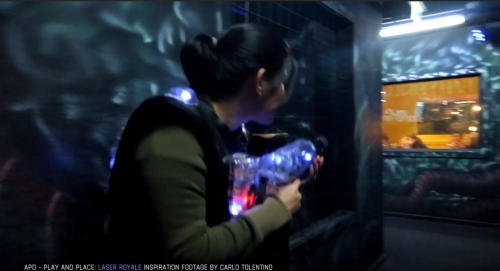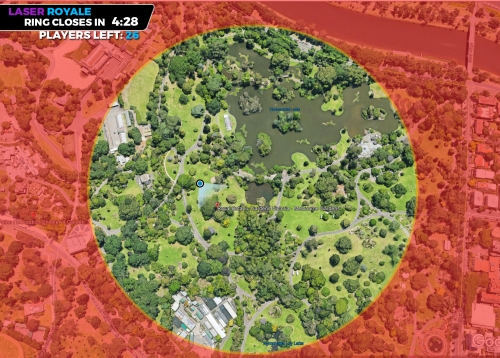THEME: Play and Place
CONTEXT:
After discussing how play and place intersect, I imagined the actual possibilities of the Battle Royale genre: digitaltrends.com/gaming/history-of-battle-royale-games/, framed with a playful twist, and with definitely less violence. Beginning from the Japanese cult classic movie Battle Royale (2003), popularized by The Hunger Games (2012), and brought to mainstream gaming with PlayerUnknown’s Battlegrounds, and Fortnite. The Battle Royale genre could is a game that is heavily influenced by the map or level and how participants strategize within its bounds.
In the context of physical location based combat, airsoft and war games are played as a sport to simulate the tactics, and survival strategies in a militaristic combat environment. japantimes.co.jp/life/2018/05/12/lifestyle/war-games-examining-fascination-recreational-airsoft-combat-games-japan/#.XVlx7ugzYuU.
The technology and mechanics of LaserTag: https://www.lasermaxx.com/ helps create a less intimidating play environment, and differentiate reality from fantasy violence or combat as a form of game or sport.
Coincidentally, there’s also a We Bare Bears episode with nearly the same mechanics and working title (Laser Royale) of what I wanted to create: https://www.youtube.com/watch?v=AD9KbpA1th8&t=240s
METHOD: To conceptualize and ideate on game mechanics of a location based game, or locative media. Additionally, to substantially conceptualize through writing, without being limited to my personal/technical skills and logistical restrictions of said game.
RESPONSE:
A locative game, in the form of a battle-royale game played with LaserTag technology in an urban or park setting, detailed through a written response. Included in the response is a concept map of the arena mobile map, and a video I took for inspiration, to develop the idea.
*Response Below:
Title: Laser Royale
Laser Royale puts people in a game of individual tactics and survival with the technology of LaserTag, akin to a battle royale game. Located in one of Melbourne’s lush urban parks, Laser Royale gives participants the opportunity to immerse themselves in a suspenseful, yet fun, and safe way of survival of the fittest.
Game Mechanics:
1. Laser Royale’s play arena, or borders are defined by a handful of checkpoints or entrance booths located within a wide urban/park area.
2. The checkpoints are where pedestrians can acquire a laser-tag vest, and gun (effective shooting range is 35 meters).
3. Players can either play solo, or in teams of two. Minimum of 12, and a maximum of 32 players.
4. Upon entering the arena, players then have 5minutes before their vests activate.
5. Players have a maximum of 100 health points, getting shot reduces their health points by 25 points. If a player’s health points is reduced to 0, the player is then eliminated (automatically shuts off their vests), and prompts them to head to the nearest checkpoint/exit. Eliminated players may also decide to spectate on the remaining survivors.
6. Getting hit by a confirmed shot makes the vest produce a feedback sound, and vibration. During this time, the player gains a brief immunity (3 seconds) to being shot.
7. A mobile phone is connected to each vest, with a mobile app acting as a GPS tracker and a map for the player. In the map, players can see information on the arena’s boundaries and checkpoints on the GPS map. Player locations are not revealed to other players on this map, however remaining player count is displayed.
8. As the game progresses, the boundaries of the arena gradually becomes smaller. Players can see this on their personal GPS map. A full match of Laser Royale is estimated to be 20 minutes long, or until there is only one player left surviving. Players who remain or are caught outside the arena’s boundaries lose 10 health points per second until they are eliminated.
9. Players have a limited amount of ammo charges, and can only acquire more once a few seconds have passed for recharge. (20 maximum ammo charges, 5 seconds per 1 ammo recharged).
10. A number of guards or referees are scattered around the map, to ensure safe and fair play within the arena. These guards and referees mediate and help collect the LaserTag vests of eliminated players.
11. The game ends when there is one player or one 2-player team is left standing.
12. Improvise, Adapt, Overcome, Survive, and Have Fun!
REFLECTION:
This is the first time I developed a response that is almost purely just conceptual and in writing. I found it liberating, not having to rely on my technical skills, or search for online tutorial know-hows in creating a response that could translate an idea. I think having an interactive/game treatment for my response is appropriate for the scale and logistics of developing games or play within a space or more significantly, a place.
Engaging with play and place with the Battle Royale genre, came from when I was at my nephew’s birthday party in a laser tag arena later during the week. I initially thought about how the size and alien-like aesthetics of the laser tag arena could be used for different games other than laser tag. But then I thought about how it would also be interesting to bring laser tag outside of its own borders or play space. I gravitated towards the latter, as I imagined what it would feel like having a large group of people playing laser tag in Melbourne’s Royal Botanical Gardens.
I wanted to explore why the Battle Royale genre is so popular in mainstream media. Could it be that people like the violence? Or perhaps the visceral experience of representing Darwin’s evolutionary theory of survival of the fittest? Laser Royale, despite being packaged as an alternative take on laser tag, aims to let participants experience the authenticity of survival in the moment-to-moment situations of a battle royale. While the concept of a battle royale may be too intense, barbaric or gruesome, I believe that people who are placed in a location based low-stakes laser tag scenario may exhibit interesting and liberating human interactions.
In Mary Flanagan’s Locating Play and Politics: Real World Games & Activism, Brian Sutton-Smith argued that play is never innocent, linking play with taboo and survival issues. Laser Royal does not wish to glorify violence, but explore the liberatory possibilities of play. The place Laser Royale, is conceptualized to be held on is any urban park environment, where participants could reimagine it as a battle zone through the act of competitive playing. The gradual closing and changing of the arena’s bounds or “magic circle” within Laser Royale, gives it, as a location-based or locative game, a more dynamic interaction with the place it is conducted on.
In conceptualizing the mechanics of Laser Royale, I also took inspiration in UK art group Blast Theory’s Can You See Me Now (2001). Where they combine location based, digital and real world interactions, in a game where people chase each other in the city. In Flanagan’s document, she quotes Kate Richards writing: Blast Theory’s work is important because their projects are able to: extend user and audience affect outside the game rather than delimiting our consciousness to the stereotypical and virtual, the game play pushes us to understand aspects of communities, our social responsibility and ourselves. This is partially achieved by the very visceral game play - in CYSMN? the players and game play self-generate affects of pursuers and pursued. Flanagan adds that in CYSMN? The landmarks, structures and streets become abstracted space, divorced from their meaning. In Laser Royale, and perhaps in a situation of survival of the fittest in a combat warzone, it is thought-provoking to that the highly-competitive people will disregard the meaning of a place, and methodically regard them as strategic terrain.

